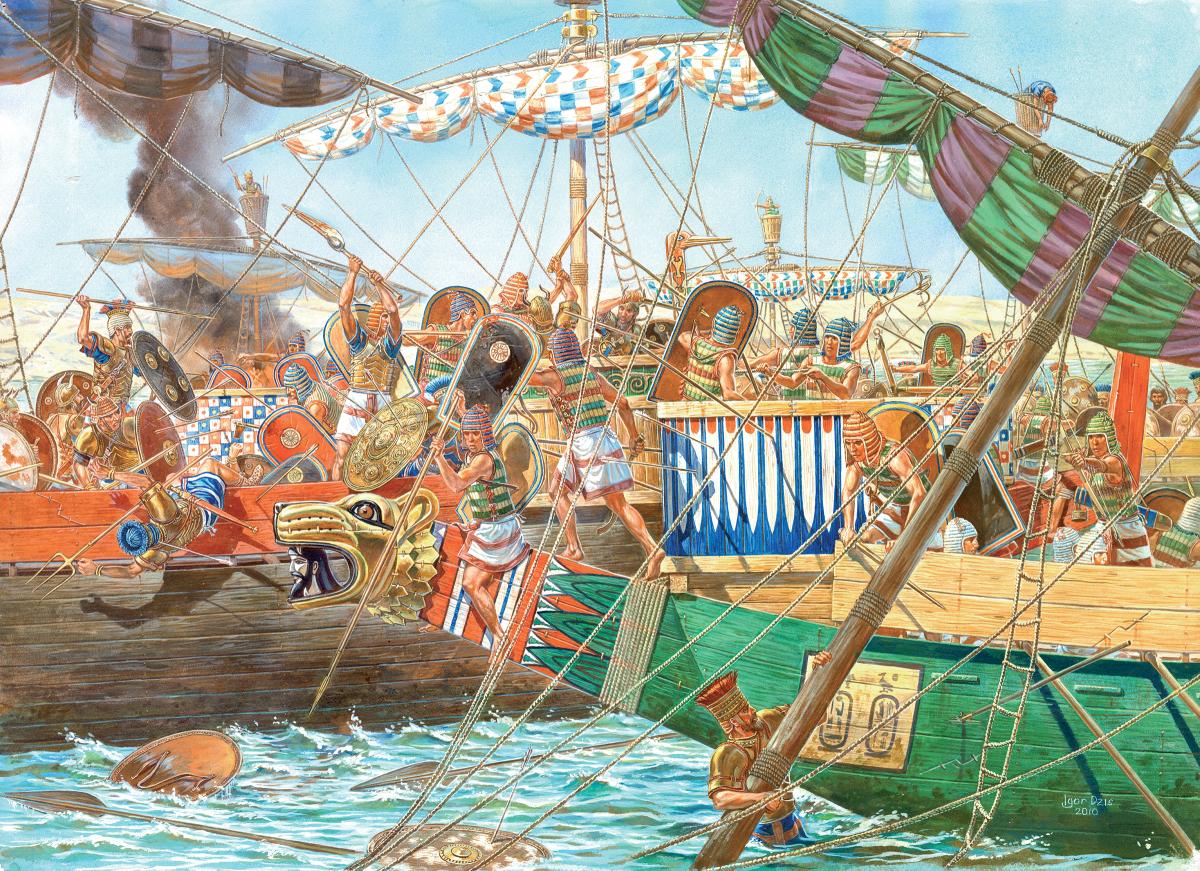Like the sea herself, the history of naval warfare is vast and deep, spanning hundreds of battles stretching back more than 3,000 years. The avid time traveler among such a bountiful heritage can spend hours musing over which was the largest naval battle, which was the most important, which was the most decisive—but what about: Which was the oldest?
As far as being the first noted in history’s annals, the honor goes to the Battle(s) of Alashiya, a trio of engagements culminating ca. 1210–1205 BC with the defeat of the Cypriots by the Hittite fleet. But it’s just a bare-bones mention (part of a Hittite burial-chamber inscription listing victories and conquests), akin to a headline without a story.
For the first naval battle in recorded history for which there are details of the action, we must go to the west bank of the Nile River, amid the ruins of ancient Thebes, to the sprawling Temple of Ramesses III at Medinet Habu. There, on the outer wall of the second pylon, you will see the longest hieroglyphic inscription ever found. And in those intricate logographic carvings, the ancients bestowed to future generations a battle narrative; essentially, the great chronicle of naval history down through the ages begins right here.
The Battle of the Delta, ca. 1175 BC, is the name we give to this first-ever described clash of fighting ships. The hieroglyphic text is supplemented by elaborate, detail-filled visual depictions in relief on the temple’s outer north wall; we see the lion-headed prow of the Egyptian galleys, the enemy galleys with bird heads carved at bow and stern; the masts, the crow’s nests, the oars, the furled sails; the rectangular shields of the Egyptians, the rounded shields of the enemy; the Egyptian bows, the enemy spears.
Who was this enemy who posed such an existential threat to Egypt during the reign of Ramesses III, so-called “last of the great pharaohs”? The same enemy who had been plundering across the Mediterranean world, laying waste to cities, ravaging coastlines: a conglomeration of displaced Late Bronze Age rovers known as the Sea Peoples. It was a time of unrest and upheaval, a time in which the tenuous fabric of civilization was in tatters. Mycenae was collapsing, the Hittite Empire was falling—all this cascading disarray exacerbated by (and swelling the ranks of) the Sea Peoples. Working their way around and down the Levantine coast, their fleet raiding by sea, their armies by land, the Sea Peoples were poised, in the words of the Chronicle of the Pharaohs, to become “a tidal wave that was to break upon the shores of Egypt.”
But Ramesses III managed to stop the tidal wave. First, he led his troops to the eastern frontier to confront the Sea Peoples’ invasion by land. When they advanced, the armed-to-the-teeth Egyptian army crushed them. But the pharaoh realized an invasion by sea also was imminent. As the enemy ships hovering off the coast of Gaza made their move into the mouth of the Nile, the Egyptian fleet was arrayed and ready.
“I was prepared and armed to trap them like wildfowl,” Ramesses proclaims in his temple inscription. “The chiefs, the captains of infantry, the nobles, I caused to equip the harbor-mouths like a strong wall, with warships, galleys, and barges. They were manned completely from bow to stern with valiant warriors . . . being like lions roaring upon the mountain-tops.”
While the pharaoh’s ships formed a line of defense, ranks of Egyptian archers crowded along the papyrus reed beds rimming the shores of the Nile Delta. Marine archers, as well, stood on board the ships waiting to rain down hell. The Sea Peoples were sailing into the jaws of a trap. “As for those who had assembled before them on the sea,” recounts Ramesses, “the full flame [the Egyptian sea force] was in their front, before the harbor-mouths, and a wall of metal [the Egyptian land force] upon the shore surrounded them.”
As the enemy fleet entered the Nile, Ramesses ordered the shoreline bowmen to let fly. Their relentless volleys of deadly arrows drove the invading ships toward the Egyptian fleet, which was now moving to block the exit. The pharaoh’s galleys rammed, withdrew, then rammed again, while the marine archers showered the crowded enemy decks. Grappling hooks yanked in the invading vessels, and the Egyptians boiled over the side, giving no quarter, the decks becoming a scene of slaughter. The invaders were “slain and made heaps from stern to bow of their galleys,” Ramesses declares, “while all their things were cast upon the water.”
The pharaoh had succeeded where others had failed—he had fought back the people from the sea. But as the years and centuries passed, there would be other people, from other seas, adding their chapters to the saga of naval history.
Hieroglyphic inscriptions of Medinet Habu, James Henry Breasted, trans., Ancient Records of Egypt: Historical Documents, Volume IV—the Twentieth to the Twenty-Sixth Dynasties (Chicago: University of Chicago Press, 1906), 38–39.
Peter A. Clayton, Chronicle of the Pharaohs (London: Thames & Hudson, 1994, 2006), 161–63.
Trude Dothan and Moshe Dothan, People of the Sea: The Search for the Philistines (New York: Macmillan, 1992), 14–22.
O. R. Gurney, The Hittites (New York: Penguin, revised ed. 1990), 38.
Barbara Mertz, Temples, Tombs and Hieroglyphs (New York: Coward-McCann, 1964), 295–97.



